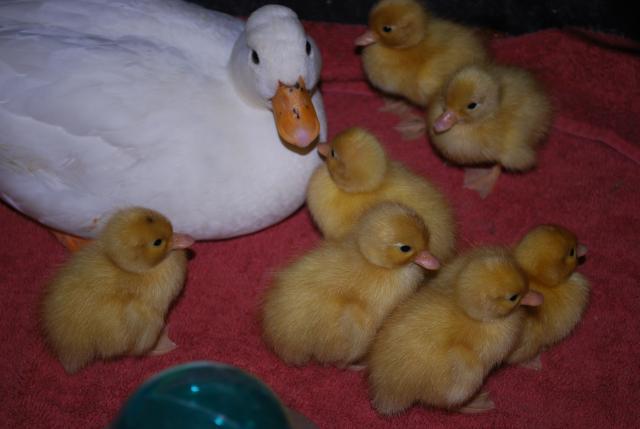- Thread starter
- #21
Quote:
Well I can't stress enough that everyone interested in Calls (or if you have some already) should by the book titled "The Call Duck Breed Buck" by Dr. C. Darrel Sheraw. It is a great read and very informational, I have learned so much from just this one book and if I ever have question it never fails to give me good sound advice about Calls. O.k. on info about the breed... here I go!
Earliest known Calls from Holland
The earliest Calls were called Dutch Decoys
Hunters used the females loud quack to bring down wild ducks
Head: Large, round with high crown, rising abruptly from bill, full cheeks
Bill: broad and short, max length 1 1/4 inches, set squarely in the head
Eyes: Large, round, alert
Neck: Short and thick
Body: Small and compact, broad and deep, full breast
Tail: carried almost level
Legs and Feet: Short, set midway in the body
Weights: Drake: 1-1/4- 1-1/2 lbs, Duck: 1-1-1/4 lb
Original Calls were Grey (Mallard)
Varieties
Gray
White
Snowy
Spotted
Blue
Buffs
Magpie... and many many more... way to many to list lol
Common Ailments of the Call Breed
Sinus Infections
Brooder Pneumonia
Eye Infections
Fertility Problems
Enteritis
Gape Worms
Poor Feathering... again way to many to list... lol
Production, fertility, and hatchability must be controlled long before the hatching season to heighten the chances of a great hatch
Proper diet, oyster shell
Vigor in the females as well as the males
Turning the eggs four times a day helps
Keep every thing very clean to stop bacterial infection in eggs
Often times the ducklings with smallest bills or the ones most to the standard have the most trouble getting free from the egg, sometimes even if they make it free they never really thrive even into adulthood, some without proper vigor to breed successfully, that is why if you plan to breed Calls you must also take into consideration the vigor and health of the birds sometimes even before the small size or how close they are to the standard, often hatchability goes done the drain due to poor pedigreed matings
Lol lots and lots more info where that came from hope this helped
Well I can't stress enough that everyone interested in Calls (or if you have some already) should by the book titled "The Call Duck Breed Buck" by Dr. C. Darrel Sheraw. It is a great read and very informational, I have learned so much from just this one book and if I ever have question it never fails to give me good sound advice about Calls. O.k. on info about the breed... here I go!
Earliest known Calls from Holland
The earliest Calls were called Dutch Decoys
Hunters used the females loud quack to bring down wild ducks
Head: Large, round with high crown, rising abruptly from bill, full cheeks
Bill: broad and short, max length 1 1/4 inches, set squarely in the head
Eyes: Large, round, alert
Neck: Short and thick
Body: Small and compact, broad and deep, full breast
Tail: carried almost level
Legs and Feet: Short, set midway in the body
Weights: Drake: 1-1/4- 1-1/2 lbs, Duck: 1-1-1/4 lb
Original Calls were Grey (Mallard)
Varieties
Gray
White
Snowy
Spotted
Blue
Buffs
Magpie... and many many more... way to many to list lol
Common Ailments of the Call Breed
Sinus Infections
Brooder Pneumonia
Eye Infections
Fertility Problems
Enteritis
Gape Worms
Poor Feathering... again way to many to list... lol
Production, fertility, and hatchability must be controlled long before the hatching season to heighten the chances of a great hatch
Proper diet, oyster shell
Vigor in the females as well as the males
Turning the eggs four times a day helps
Keep every thing very clean to stop bacterial infection in eggs
Often times the ducklings with smallest bills or the ones most to the standard have the most trouble getting free from the egg, sometimes even if they make it free they never really thrive even into adulthood, some without proper vigor to breed successfully, that is why if you plan to breed Calls you must also take into consideration the vigor and health of the birds sometimes even before the small size or how close they are to the standard, often hatchability goes done the drain due to poor pedigreed matings
Lol lots and lots more info where that came from hope this helped





